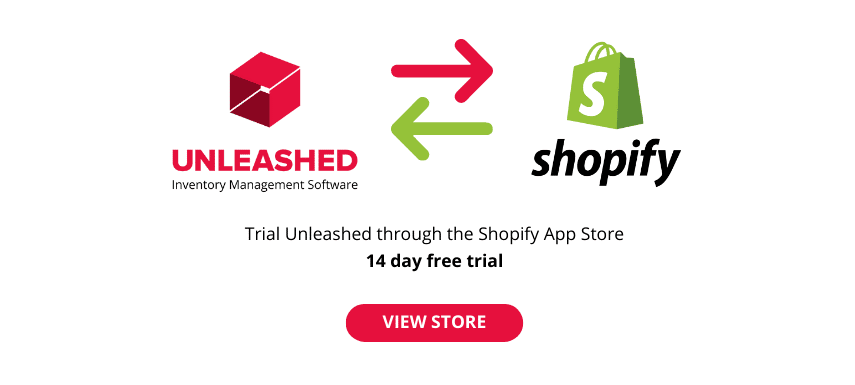
Manufacturers and brick-and-mortar retailers have been using software to manage their inventory for years – but inventory management is even more important when you’re running a business that operates in the complex eCommerce space.
Here we examine the ins and outs of eCommerce inventory management: The challenges, the solutions, and how to optimise your systems for maximum efficiency.
What is eCommerce inventory management?
Inventory management for eCommerce is the process of monitoring and organising inventory for online retail, from sourcing products through to shipping customer orders.
eCommerce inventory management is critical for streamlining operations and meeting customer expectations. It allows an organisation to track how much inventory it has at a given time, where that inventory is, what it’s worth, and where it needs to go next.
How do eCommerce stores manage inventory?
Many online businesses invest in eCommerce inventory management software to manage and track all their inventory data. For most, it’s viewed as an essential part of their tech stack.
In a nutshell, modern inventory management software is a cloud-based software-as-a-service (SaaS) product designed to connect your people, warehouse and systems together into a single platform.
From there it can:
- Track real-time stock levels with barcode scanners and automatic data entry
- Track inventory across its lifetime by batch or serial number
- Inform you where each individual item is located across multiple warehouses or shipping carriers
- Record details about each product such as weight, dimensions, cost and price
- Help you forecast demand
- Automatically inform you when certain items are running low on stock (or about to hit maximum preferred stock levels), so you can restock or stop buying before it’s a problem
 While you can use spreadsheets to manage your inventory, the process is time-consuming – and if you have more than one warehouse or online store, real-time inventory data is essential
While you can use spreadsheets to manage your inventory, the process is time-consuming – and if you have more than one warehouse or online store, real-time inventory data is essential
Why optimised inventory management is critical in eCommerce
As an eCommerce store, we imagine you’re dealing mostly in finished goods. That means your inventory is one of your biggest company assets, and any loss here is serious money down the drain. Your capital is tied up in these goods until sold, so the more you can streamline the process of selling your products, the healthier your bottom line will be.
Inventory management is a critical process in that streamlining effort. It deals with making it easier to track and analyse the comings and goings of your warehouse, so you always know:
- Where something is coming from
- Where it’s going
- Where you’ve stored it
- How much it’s worth
- How long it’s been stored in your warehouse
- What times of year you would expect to sell more or less of that product
While this is important for all inventory, it’s even more important for products with a short shelf life – like perishable food products or seasonal / promotional items. These are items where over- or under-stocking is harder to recover from, not to mention the risk of spoilage.
 With eCommerce’s increasingly important role in both B2C and B2B markets, making sure your inventory is managed properly has become central to any business that retails online
With eCommerce’s increasingly important role in both B2C and B2B markets, making sure your inventory is managed properly has become central to any business that retails online
eCommerce inventory management for multi- and omnichannel sellers
Managing an omnichannel or multi-channel eCommerce business model can be very challenging if you don’t have a firm handle on your inventory control, and especially if nothing has been automated.
Overselling is a common challenge, and a great example.
When you move to omnichannel retail, and your system can’t manage itself, you may inadvertently sell the same product on two channels when you only had one item in stock. One customer gets the product, the other goes away unhappy.
With a multi-channel inventory management platform, your system would have seen that only one product was in stock, mentioned that publicly on both channels, and informed whichever customer came second that they had missed out. Perhaps it would also give them an opportunity to sign up to hear when the product came back in stock.
Common challenges of eCommerce inventory management
eCommerce presents unique challenges when it comes to managing inventory.
High sales volume, capricious supply chains, and an ever-changing market make for a highly volatile industry.
Here are the 5 most common challenges in eCommerce inventory management:
- Stock in the wrong place: If you manage multiple warehouses, but can’t track the location of your products, you run the risk of keeping important items in the wrong section of your warehouse – or perhaps even the wrong part of the country.
- Not enough stock: Sudden surges in demand can happen at any time, and if you aren’t confident about when these surges will occur, or you don’t have an appropriate amount of safety stock (or perhaps operate a just-in-time business model) then you may stock out during these waves.
- Too much stock: The opposite problem to the above. Sudden troughs in demand may also occur at certain times of year, leading to slow inventory turnover and higher carrying costs as a result. Wastage is sure to follow for items with a limited shelf life, like perishables and seasonal items.
- Forgetting stock: How often have you gone into the back of the warehouse and found goods unsold from years ago? These dust-gatherers are locking up capital that could be otherwise spent on growing your business. Forgetting stock by not understanding what items are where, and what hasn’t been sold yet, is a needless waste of money.
- Inability to communicate with customers: At the end of all of the above is the customer – and an unsatisfied customer at that. Customers may forgive stock delays and problems with the supply chain, but only if a business is open, honest, and quick to communicate. But you’ll struggle to communicate if you don’t have good control of inventory because you may not know what’s wrong and therefore can’t explain it to the customer in a timely – if not immediate – fashion.
Learn more: Real-time inventory control for your eCommerce business
The benefits of eCommerce inventory management
All those challenges simply emphasize the need for a sophisticated inventory management system.
Some popular benefits of automated eCommerce inventory management include:
- Gather data: By controlling your inventory through software, you can gather real-time data on your stock. This can help to spot red flags and money pits on the go, as well as predict future demand by comparing historical sales data to predicted future trends, such as upcoming seasonal events.
- Reduce waste: By carefully tracking expiry dates and other factors in real time, you’ll have a clear picture of your risk of waste via spoilage and can push those products accordingly. Additionally, if you’re forecasting future demand, you can purchase new inventory to match reality – so there’s less chance you’ll stock out, or buy too much.
- Streamline processes: Inventory management practices reduce not just product waste, but time wasting too. Your staff can spend less of their day on menial picking, sorting or data entry tasks, and more doing value-adding activities like strategy or upskilling.
- Share information: Connecting your various processes together into a single system is a part of the inventory management onboarding process. The side benefit of this is that this interconnection of systems means they can talk to each other clearly, so you can start to compare all sorts of factors from different business units to spot trends and opportunities. This includes not just inventory, but sales, financials, marketing, HR, supply chain management, and more
- Improve satisfaction: With a better handle on your inventory, and predicted future demand, you’ll be better placing your business to satisfy customer orders in a timelier fashion, with fewer chances of errors – even on complex split shipments.
 Many of the benefits of effective inventory management come back to one key thing: customer satisfaction.
Many of the benefits of effective inventory management come back to one key thing: customer satisfaction.
eCommerce inventory management methods and strategies
Managing eCommerce inventory can seem a daunting task.
But with the right budget and strategy in place, you can minimise the number of challenges and stay on top of your stock regardless of what the future brings.
First, let’s make sure you’ve got enough cash to safely cover all your inventory costs.
How to finance your eCommerce inventory
Inventory financing is something many businesses fail to consider when creating an eCommerce inventory management strategy. But without money to pay for stock, it’s tough to meet customer demand.
If your business is experiencing a surge of growth and you don’t have the cash to purchase sufficient stock, you’ll need a plan to cover cash flow gaps.
Before you commit to any one strategy, consider these financing options:
- Equity finance
- AR financing
- WIP financing
- Crowdsourcing
- Merchant cash advances
Some of the methods we cover below may also provide a solution to cash flow problems. If you operate with a lean manufacturing mentality (even if you’re not a manufacturer), you can minimise inventory costs by never holding more stock than you need.
5 effective strategies for managing eCommerce inventory
Managing inventory efficiently is all about having the right tools and strategies in place.
In other words, there is no blanket-solution for businesses; what works well for some may be disastrous for others.
Below are five common eCommerce inventory management strategies and who they’re suited for, so you can pick the one that’s most suitable for your unique business.
First in, first out
First in, first out (FIFO) is an inventory strategy where the first products to be received by the seller are the first to be fulfilled for customers.
This method favours the medical industry and food and beverages industry, as it allows you to avoid spoilage by getting rid of old stock first (before it can expire).
Just-in-time inventory control
Just in Time (JIT) is a lean approach to managing inventory. It involves keeping only enough stock to fulfil orders as they’re placed, rather than carrying a large amount of safety stock.
This method works well for companies selling seasonal products because it prevents ending up with a large amount of money tied up in dead stock when the season ends.
Just-in-case inventory control
Just in Case (JIC) inventory is an inventory control strategy where businesses prioritise keeping adequate levels of safety stock on hand. This helps to reduce the risk of insufficient stock when a surge in demand or a disruption in the supply chain occurs.
This model was popular in the early 20th century – possibly, it was the only strategy at the time. As businesses got better at forecasting, many switched to JIT models.
However, uncertainty and frequent supply chain issues in recent years have created a new demand for safety stock and have seen many businesses return to the JIC model.
- Learn more: See our research into why thousands of companies are now relying on JIC inventory control.
 Selecting the right eCommerce inventory management strategy for your business will help you stay on top of your stock levels and cash flow from the start.
Selecting the right eCommerce inventory management strategy for your business will help you stay on top of your stock levels and cash flow from the start.
Third-party logistics (3PL)
Third-party logistics companies (3PLs) are a way for sellers to take a hands-off approach to the physical process of managing inventory and fulfilling orders.
3PLs are a handy solution for businesses that would rather focus on the marketing and growth aspects of running a business. However, they can have a big impact on your margins.
If you’re selling low-value stock with thin margins and large dimension, it may not be worth investing in a third-party fulfilment option as these businesses often charge per order or per item fulfilled – as well as an additional fee for storage
Always ask lots of questions and assess the ROI of using a 3PL before committing to a contract.
Dropshipping
Dropshipping is a low-cost inventory strategy where products are shipped directly from your supplier to the customer (without ever touching your hands).
This method is best suited to first-time sellers with little or no capital since it doesn’t require a warehouse or staff to fulfil orders. The downsides are that quality control, customer service, and fast shipping times are almost non-existent.
Many successful eCommerce businesses use dropshipping to test new products before switching to a more sustainable, such as Just-in-Case, inventory management method once demand has been evidenced.
eCommerce inventory management metrics and formulas
Once you’ve got your strategy in place, you’ll need to continuously monitor and test how efficient your inventory processes are.
Consider monitoring at least these five useful eCommerce inventory KPI metrics:
Inventory turnover rate
Cost of Goods Sold / Average Inventory = Inventory Turnover
What it tells you: Inventory turnover rate measures whether you’re keeping sufficient stock on hand levels and helps you forecast future inventory requirements.
Inventory accuracy
Database Inventory Count / Physical Inventory Count = Inventory Accuracy
What it tells you: Inventory accuracy lets you know how closely the stock levels in your system match the stock levels in your facilities, which can determine whether you need to implement more efficient picking, storing, and receiving processes.
Inventory shrinkage
(Cost of Recorded Inventory – Cost of Physical Inventory) / Cost of Recorded Inventory = Inventory Shrinkage
What it tells you: Inventory shrinkage measures how much of your stock frequently gets lost for good – whether due to theft, damage, spoilage, or something else.
Inventory-to-sales ratio
End of Month Inventory Balance / Sales for that Month = Inventory to Sales Ratio
What it tells you: Inventory-to-sales ratio tells you how much stock you have on hand in a given period compared to the total number of orders fulfilled in the same period.
Customer backorder rate
Total Orders Delayed Due to Stockouts / Total Orders Placed = Backorder Rate
What it tells you: Customer backorder rate measures the accuracy and efficiency of your inventory forecasting processes.
Optimise your processes with eCommerce inventory management software
Developing a tech stack for managing your stock is the biggest leap in efficiency you can make. And right now, there’s software out there that does just about everything.
Let's break down what a reliable software stack looks like for online sellers.
The ideal eCommerce inventory management software stack
From sales order processing to managing stock levels and reordering – the opportunities for automation are endless.
To save you the hassle of reading a thousand product reviews and comparing endless pricing and features, we’ve put together this example of an optimised eCommerce inventory software stack.
Here’s how your eCommerce inventory management software stack might look:
- Shopify or Amazon to function as your digital shopfront, where customers can make purchases.
- Unleashed for managing all your sales order, inventory, and purchasing information.
- Xero or QuickBooks for keeping track of cash flow, taxes, loans, and purchases.
- A2X for bringing all that sales data from your various channels into Xero and QuickBooks.
- StockTrim for forecasting your stock levels and making better informed ordering decisions.
- Prospect for tracking all your customer and sales data.
5 features to look for in good eCommerce inventory management software
Choosing the right software will enable you to speed up your inventory processes, align your various business goals, and boost the accuracy of your product data.
Here are our five key features to look for when choosing eCommerce inventory software:
1. Real-time data analytics
Business improvement comes from good data. Being able to gather evidence about your business allows you to perform a thorough SWOT analysis and make data-based strategic decisions about what to do next, where to expand, and what to buy.
This data should come through in real time, or as close to it as possible. Without this feature, you can’t determine what stock you have, where it is, and where it needs to go. In the fast-moving world of eCommerce – and omnichannel eCommerce at that – a lack of real-time visibility can lead to errors. And errors lead to unsatisfied customers.
2. Barcode scanning and serial number (or batch) tracking
In order to make data entry as smooth as possible, you have to eliminate it where possible. Barcode scanning is one crucial way to achieve this, allowing pickers and sorters to update the system with the push of a button – no menial data entry needed on their part, and therefore they can move faster and make fewer errors.
If your system can also track products via serial number or batch, you gain visibility across a product’s entire lifetime, from the manufacturer (if that company is different to yours) all the way through to shipping and delivery. Then if products ever come back up the supply chain in the form of returns or maintenance, you still have all that historical data to know where it’s been and when it was sold.
3. Real-time inventory value tracking
Your warehouse managers might be more concerned with the what and where of your stock, but your accounts team and management are going to want to know the value of these goods.
With a live view of inventory value, historical inventory turnover data, and the ability to track additional variable costs like courier fees or spoilage, you'll have the power to accurately monitor your company’s complex finances – potentially helping you find money pits, or opportunities to invest and grow.
 Look for features like real-time data, inventory value tracking and supplier management to optimise your inventory processes
Look for features like real-time data, inventory value tracking and supplier management to optimise your inventory processes
4. Supplier management
The quality of your customer experience starts with your suppliers. So, knowing where your goods are coming from, what they’re costing you, and understanding the quality of these goods (i.e., goods sold versus goods returned), will put you in a position where you can make evidence-based decisions on who to purchase from, and who to drop.
Beyond that, inventory management software with a supplier management feature should also automatically generate purchase orders, store supplier details centrally, generate quantity discounts, record transaction histories and more. Each of these functions takes a degree of manual labour out of your day, giving you more time to do what you do best.
5. Adaptability
Finally, a degree of configurability is always welcome in any SaaS product, inventory management included. Every business is unique, so you’ll want to find software that can be adjusted – even if only a little bit – to better suit the specific needs of your industry or business model.
This adaptability should also extend to plug-ins. Look for inventory management software that plays nice with others, such as ERP systems, marketing or sales databases, and of course eCommerce platforms.
Considerations before investing in inventory management software
Make sure that before you invest in software, you’ve taken time to reflect on your organisational needs regarding the software. If you want to make the most of any new purchase, that purchase must be well-suited to your business type, goals and organisational strategy.
So, ask yourself:
- How many users will require access to the platform?
- How scalable is the software if we grow or shrink?
- Is the software compatible with my existing platforms – like ERP or eCommerce – or compatible with the ones I am considering?
- What will it cost, either up-front or on a rolling basis? What is my budget?
- Does the system need any on-premise hardware or can it be accessed remotely? If it can be accessed remotely, can it be accessed via mobile or strictly desktop?
- What support does the provider offer, in the form of both resources and contact people?
For some SMEs it may feel like a serious cost to invest in new software – especially if you’re used to doing things yourself.
But the reality is that SMEs can benefit from better inventory control as well as – if not more than – larger enterprises: in a business where every dollar counts, saving those dollars has a larger impact.
So that investment cost must be considered against what it’s costing you or your team to manually carry out the processes we’ve discussed above.
 To calculate if inventory software is worth the cost, think about how long your personnel – including pickers, sorters and back-office staff – are spending on manual data input.
To calculate if inventory software is worth the cost, think about how long your personnel – including pickers, sorters and back-office staff – are spending on manual data input.
Here’s an exercise for you if you’re worried about cost
Consider your annual salary – or that of whoever it is in your company this most applies to.
Now ask yourself how many minutes or hours they spend each day (or week, if that’s easier) on data entry and data management. Consider the time your pickers and sorters spend manually inputting inventory data into your current system. Also calculate the time your financial team has to take sorting through pages of Excel sheet data to look for the information they require.
Then take into account any money you’re losing on, say, a quarterly basis from spoilage, clearance discounts for unsold stock, and lost business due to stockouts.
These are the easy losses to calculate – you may also be losing money on missed business opportunities due to not foreseeing trends, inefficiencies in your supply chain, or poor customer satisfaction.
If all of that data entry were instant, and those inefficiencies were to be cut, how much would you save per week or month – and does that offset the rolling cost of an inventory management product?
- Learn more about businesses using inventory management software to find out how they’re using it and what it’s done for their businesses.
Simplify your eCommerce inventory management with Unleashed
We recognise that we’re biased towards inventory management, since it’s what we work hard on to make people’s lives easier.
In short, Unleashed has the functionality to do everything we’ve talked about in this article. From inventory tracking and data analytics to supplier management and easy integration, it covers every major feature that an SME eCommerce business should need for its day-to-day inventory control.
Even better – Unleashed provides its own dedicated B2B eCommerce platform, meaning your B2B eCommerce and inventory software work together seamlessly.
And Unleashed also integrates with major eCommerce platforms like Shopify and Amazon to streamline your eCommerce inventory management.

